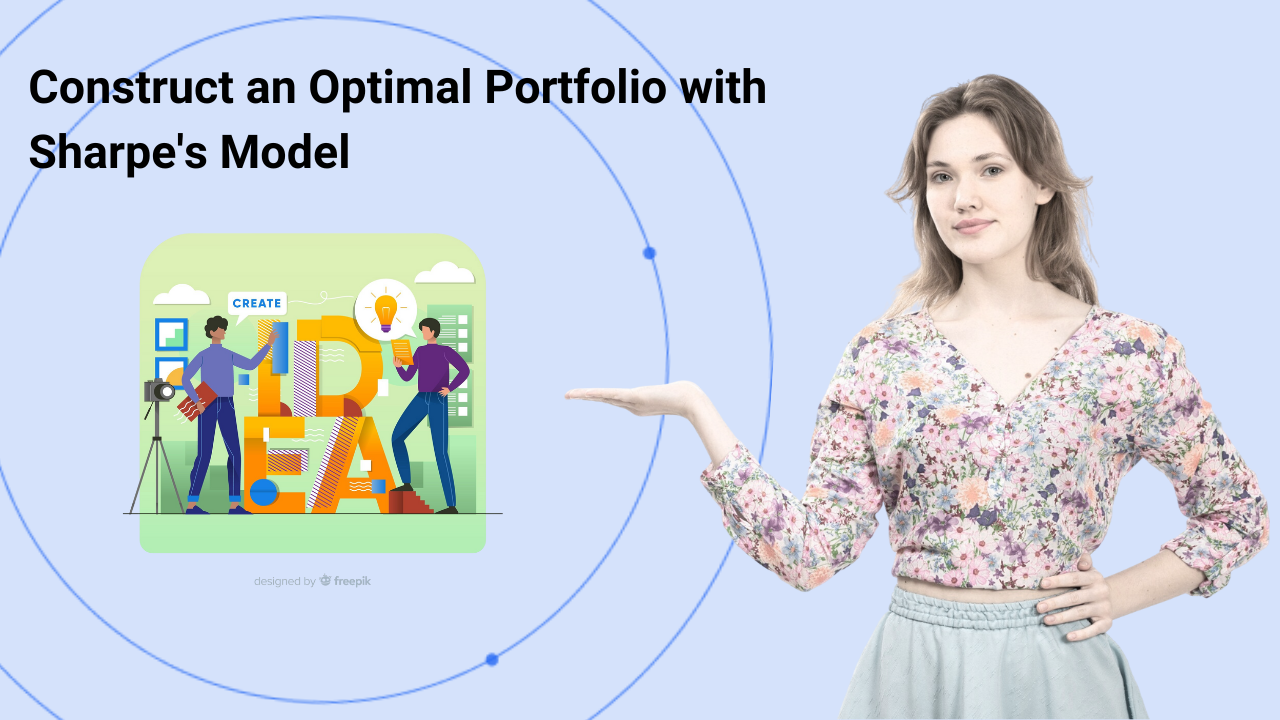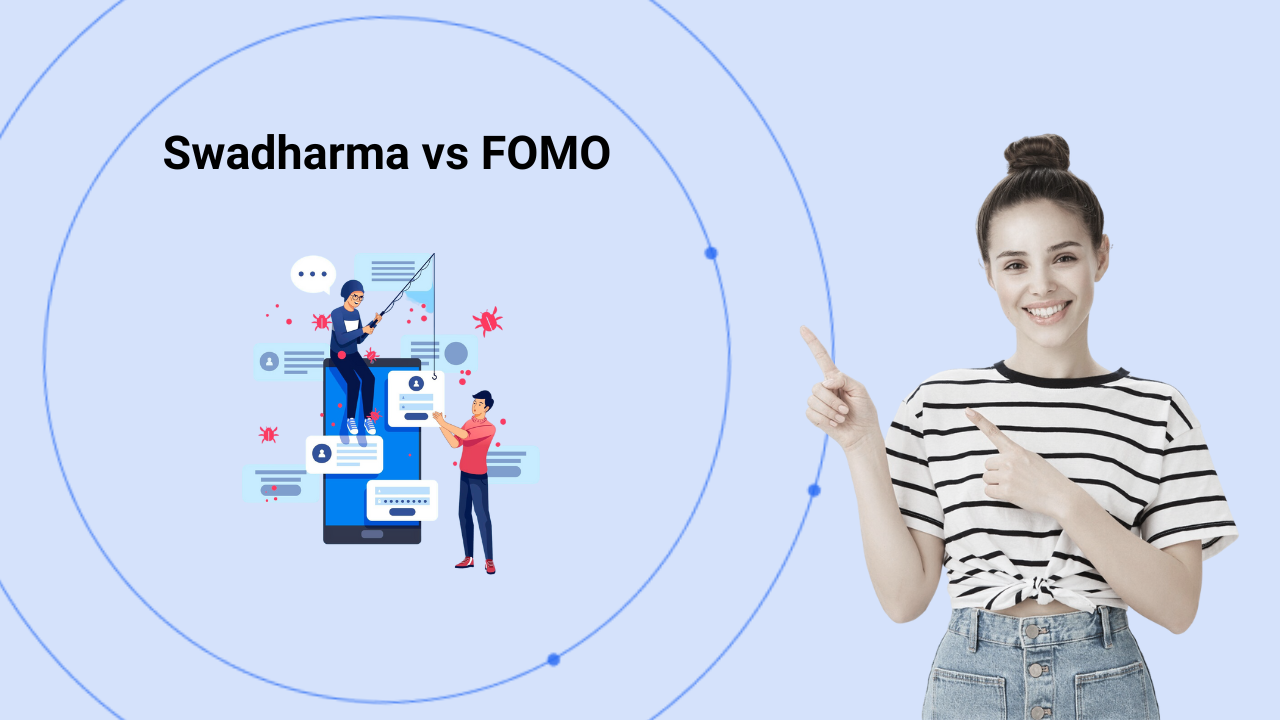Constructing an optimal portfolio involves balancing risk and return to meet investment goals. Sharpe’s Single Index Model simplifies this task by considering the market index as the sole factor influencing asset returns.
In this blog, we will walk you through how to use Sharpe’s model to build a diversified portfolio, leveraging its risk-return trade-off to optimise your investments.
What is Sharpe’s Single Index Model?
Sharpe’s Single Index Model is an investment tool that assumes asset returns are primarily influenced by a single factor—the market index. Developed by William Sharpe, this model helps investors simplify portfolio construction by focusing on the relationship between individual assets and the broader market.
The model calculates the expected return of an asset using two key components: the risk-free rate and the asset’s sensitivity to market returns, measured by beta. This simplifies the process of determining an asset’s risk and return in comparison to the entire market. While the model assumes that market returns are the sole influencing factor, it remains a useful tool for constructing a diversified and optimised portfolio.
Sharpe’s Single Index Model is widely used due to its ability to provide a clear, data-driven framework for evaluating assets. By using the model, investors can build portfolios that achieve the best possible return for a given level of risk.
Key Assumptions of the Single Index Model
Sharpe’s Single Index Model relies on several assumptions that simplify the process of portfolio construction. Understanding these assumptions is crucial to applying the model effectively and knowing its limitations:
- Linear Relationship with Market Index:
The model assumes that the returns of individual assets are directly influenced by the returns of the market index. The relationship is linear, meaning if the market index goes up by a certain percentage, the asset’s return will also change in proportion, depending on its beta. - Homogeneous Expectations:
All investors are assumed to have the same expectations regarding the market’s risk and return. This means that everyone evaluates the market’s future performance based on the same assumptions and calculations, which simplifies portfolio construction but may not reflect individual preferences. - Single Risk Factor:
The model simplifies the complex relationships between different assets by assuming that only the market index (or a market factor) influences asset returns. It disregards other factors like sector-specific risks, interest rates, or macroeconomic conditions. - Uncorrelated Residual Risk:
The unsystematic risk (or residual risk) of each asset is assumed to be independent of the other assets. This means that the non-systematic risk of one asset does not affect the non-systematic risk of another asset, which is an idealised assumption.
While these assumptions make the model easier to use and apply, they also represent limitations, as real-world markets may be influenced by multiple factors beyond just the market index. Despite this, Sharpe’s model remains a valuable tool for simplifying portfolio optimisation.
Steps to Construct an Optimal Portfolio Using Sharpe’s Model
Building an optimal portfolio using Sharpe’s Single Index Model involves several steps, which help in selecting assets that provide the best risk-return trade-off. Here’s how you can apply the model in a step-by-step manner:
- Step 1: Gather Data on Individual Assets and Market Index
The first step in using Sharpe’s model is to gather historical return data for the assets you’re considering and for the market index (e.g., Nifty 50 or S&P 500). You need data on returns, standard deviations, and the correlation between each asset and the market index. This data can usually be sourced from financial databases or platforms like Streetgains. - Step 2: Calculate the Expected Return of Each Asset
Next, calculate the expected return for each asset in your portfolio. This is usually done using the historical average of returns. A simple way to do this is to take the arithmetic mean of the asset’s past returns over a specific period. These expected returns will help estimate how each asset is likely to perform going forward. - Step 3: Calculate the Beta of Each Asset
Beta is a measure of an asset’s volatility relative to the market. To calculate it, use the formula:
Beta indicates how much the asset’s price moves in relation to the market. For example, a beta of 1 means the asset tends to move in line with the market, while a beta greater than 1 means the asset is more volatile than the market. - Step 4: Determine the Portfolio’s Expected Return and Risk
Once you have the expected return and beta of each asset, you can calculate the weighted average expected return for the portfolio. Additionally, assess the portfolio’s overall risk by considering the risks of individual assets and their correlations with each other. For this, you’ll need to calculate the portfolio’s variance, which requires considering the covariance between assets and their respective weights in the portfolio. - Step 5: Optimise the Portfolio
The final step is to optimise the portfolio to achieve the best risk-return trade-off. This can be done by adjusting the asset weights in the portfolio so that it maximises expected return for a given level of risk. Tools like Excel or portfolio optimisation software can simplify this process by running calculations and identifying the optimal mix of assets.
By following these steps, you can use Sharpe’s Single Index Model to construct a portfolio that balances risk and return according to your investment goals.
How Sharpe’s Model Helps in Portfolio Optimisation
Sharpe’s Single Index Model provides a structured framework to optimise portfolios by balancing risk and return. Here’s how it assists in the portfolio optimisation process:
- Simplifying Portfolio Construction:
The model reduces the complexity of managing multiple assets by assuming that each asset’s returns are solely driven by the market index. This simplification helps investors focus on the core market factor, making it easier to evaluate risk and return without getting overwhelmed by the intricacies of individual asset correlations. - Identifying the Best Risk-Return Balance:
By calculating the beta and expected return for each asset, Sharpe’s model helps investors identify which assets offer the best return for a given level of risk. The model allows you to select assets that are aligned with your risk tolerance while ensuring that you’re not overexposed to riskier assets. - Minimising Unsystematic Risk:
Unsystematic risk, or the risk specific to individual assets, is minimised by diversifying across assets that have low correlations with each other. Sharpe’s model allows you to construct a portfolio where the risk of individual assets is balanced, helping to reduce the overall portfolio risk. - Streamlining Decision-Making:
With Sharpe’s model, investors can make data-driven decisions based on market data, rather than relying on subjective judgement. The model provides clear criteria—beta, expected return, and risk—enabling investors to make informed decisions about asset allocation. - Adjusting Portfolio for Optimal Performance:
The model’s optimisation process helps you adjust asset weights to find the optimal portfolio allocation. This ensures that you achieve the best possible return for the level of risk you’re willing to accept. It allows for continuous adjustments as market conditions change.
Sharpe’s Single Index Model is a highly effective tool for simplifying and optimising portfolio construction, providing a clear methodology to achieve the desired balance between risk and return.
Limitations of Sharpe’s Single Index Model
While Sharpe’s Single Index Model is a valuable tool for portfolio construction, it does have several limitations that investors should be aware of:
- Oversimplification of Asset Relationships:
The model assumes that a single market index is the sole factor influencing asset returns. In reality, asset returns are often influenced by multiple factors, such as interest rates, industry-specific risks, or geopolitical events. By limiting the model to one factor, it overlooks these complexities, which can result in an incomplete analysis. - Assumption of Homogeneous Expectations:
Sharpe’s model assumes that all investors have the same expectations for risk and return, which is not always the case. In reality, investors have differing risk tolerances, financial goals, and time horizons, and the model’s assumption of homogeneous expectations may not reflect these differences. - Beta Instability:
Beta values are not static; they can change over time based on shifts in market conditions. The model relies on historical data to estimate beta, which may not accurately reflect future risk. A change in a company’s business model, industry dynamics, or market conditions can cause an asset’s beta to fluctuate, which may affect the reliability of portfolio predictions. - Ignoring Other Risk Factors:
The model assumes that beta is the only relevant measure of risk, ignoring other important factors such as liquidity risk, credit risk, and operational risk. This narrow focus may lead to an incomplete understanding of the total risk associated with an asset or portfolio. - Market Efficiency Assumption:
Sharpe’s model assumes that markets are efficient, meaning that all relevant information is already reflected in asset prices. However, markets are not always efficient, and factors like investor sentiment or market speculation can drive asset prices away from their intrinsic value.
Despite these limitations, Sharpe’s Single Index Model remains an effective tool for constructing and optimising portfolios, especially for investors seeking a simplified approach to balancing risk and return. It’s important to complement this model with other tools and strategies to account for the complexities of the real market.
Final Thoughts on Sharpe’s Single Index Model
Sharpe’s Single Index Model offers a simplified yet effective approach to constructing an optimal portfolio. By focusing on the market index as the key factor influencing asset returns, it allows investors to optimise their portfolios for the best risk-return trade-off. While the model simplifies portfolio construction and helps minimise unsystematic risk, it’s essential to recognise its limitations, such as oversimplification and potential beta instability.
Despite these limitations, Sharpe’s model remains a valuable tool for investors looking to balance risk and return with a data-driven approach. By understanding the assumptions and limitations, you can use this model as part of a broader strategy to build a well-diversified, risk-optimised portfolio. Platforms like Streetgains provide insights and research to complement Sharpe’s model, helping you refine your portfolio construction and make more informed investment decisions.
Disclaimer:
The content in this blog is intended for informational purposes only and does not constitute investment advice, stock recommendations, or trade calls by Streetgains. The securities and examples mentioned are purely for illustration and are not recommendatory.
Investments in the securities market are subject to market risks. Please read all related documents carefully before investing.
Sharpe’s Single Index Model and Portfolio Construction FAQs:
Sharpe’s Single Index Model is a portfolio construction method that assumes the returns of individual assets are influenced by a single factor—the market index. It simplifies the relationship between assets by calculating their expected return and risk based on their sensitivity to market returns, making portfolio construction easier and more efficient.
The model helps optimise portfolios by calculating the beta (sensitivity to market movements) and expected return for each asset. By adjusting the asset weights, it identifies the best risk-return balance, ensuring the portfolio provides the highest expected return for a given level of risk.
Beta measures the volatility or risk of an asset relative to the market. A beta of 1 indicates that the asset’s price moves in line with the market, while a beta greater than 1 indicates higher volatility, and a beta less than 1 suggests the asset is less volatile than the market.
Yes, the Single Index Model can be applied to various asset classes, such as stocks, bonds, and other financial instruments, as long as there is a market index available to track the asset’s performance.
The model oversimplifies the relationship between assets by assuming that only the market index influences returns. It also assumes homogeneous expectations, ignores other risk factors, and may not account for beta instability over time. These limitations can reduce the accuracy of the model in real-world applications.
To improve portfolio construction, consider complementing Sharpe’s model with other risk management tools and strategies, such as multi-factor models, to account for additional risk factors like sector-specific risks or interest rate changes. Regular rebalancing and adjusting for changing market conditions can also enhance portfolio performance.
Streetgains offers expert insights and data-driven recommendations to help you apply Sharpe’s Single Index Model in portfolio construction. With a focus on optimising asset allocations and providing detailed market analysis, Streetgains can guide you in making informed decisions to enhance your portfolio’s risk-return profile.
FAQs:
-
1. How to earn money daily from trading?
Earning money daily from trading involves strategies like day trading, where traders capitalise on small price movements within the same day. Success requires real-time market analysis, quick decision-making, and risk management.
-
2. How to earn money from equity trading?
To earn money from equity trading, you need to buy stocks at a lower price and sell them at a higher price. Success depends on researching companies, analysing stock trends, and using technical or fundamental analysis.
-
3. How to earn money from share trading in India?
In India, share trading offers profit potential through buying and selling stocks on exchanges like the NSE and BSE. To maximise returns, traders should use market research, tools like technical analysis, and risk management strategies.
-
4. How to make money from share trading in India?
Making money from share trading involves selecting the right stocks, timing the market, and implementing trading strategies like swing trading or day trading while staying informed about market trends.
-
5. How to transfer money from a trading account to a bank account?
To transfer money from your trading account to your bank, log into your trading platform, navigate to the funds section, and initiate a withdrawal request. The money will typically be credited to your linked bank account in 1 to 3 days.
-
6. How to withdraw money from a trading account?
You can withdraw funds by logging into your trading account, selecting the withdrawal option, and selecting the amount to transfer to your bank account. Ensure your bank account is linked and follow any steps your broker requires.
Subscribe to our Credits-Based Research System:
Pay only for successful research calls!












